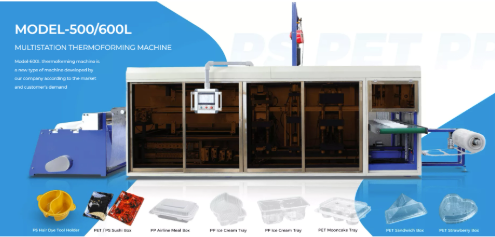Views: 0 Author: Site Editor Publish Time: 2025-09-29 Origin: Site
High-detail plastic parts need precision. Pressure Forming creates sharp edges and crisp surfaces. It rivals injection molding without high costs. In this article, we explore why Pressure Forming excels. You will learn its benefits, applications, and key advantages.
Pressure forming begins by heating a plastic sheet until it becomes pliable. The sheet is then clamped over a mold, which contains small vents. A vacuum pulls the sheet downward, while high-pressure air pushes it tightly against the mold. This dual-action process ensures that every contour and detail of the mold is captured.
Table 1: Comparison of Forming Methods
| Feature | Vacuum Forming | Pressure Forming |
|---|---|---|
| Surface Detail | Low | High |
| Sharp Corners | Limited | Crisp |
| Draft Angles | Required | Minimal |
| Tooling Cost | Low | Moderate |
| Lead Time | Moderate | Short |
Tips: Pressure forming can increase mold surface detail by up to three times compared to vacuum forming.
Pressure forming excels at producing sharp corners, defined radii, and intricate surface patterns. Logos, model designations, and styling lines can be incorporated directly into the plastic. It allows for highly precise components without compromising structural integrity.
Tips: For branding or detailed components, pressure forming ensures clarity that lasts throughout the product's lifecycle.
Tooling for pressure forming is generally made of machined aluminum, cast aluminum, or epoxy for short runs. Compared to injection molding, tooling costs can be 50–90% lower, and modifications are simpler and faster. Use replaceable inserts in the mold to update logos, textures, or openings without remaking the entire tool.
Pressure forming requires less complex tooling and can reach production within weeks. It enables rapid prototyping, quick redesigns, and fast production for small or medium runs, reducing the time to market significantly. Prioritize pressure forming for projects requiring tight deadlines and multiple design iterations.
While vacuum forming is ideal for large, simple shapes, it struggles with fine details. Pressure forming achieves sharper edges, deeper draws, and intricate surface textures, making it suitable for high-precision components. Parts with undercuts or inverted lips are generally impossible to create with conventional vacuum forming.
Injection molding produces high-detail parts on both sides but requires expensive tooling and long lead times. Pressure forming produces high-detail parts on one side, offering comparable aesthetics and durability at a fraction of the cost.
Table 2: Pressure Forming vs Injection Molding
| Feature | Pressure Forming | Injection Molding |
|---|---|---|
| Tooling Cost | Low | High |
| Re-tooling | Easy | Expensive |
| Lead Time | 6–10 weeks | 3–6 months |
| Part Complexity | Moderate | High |
| Surface Detail | High (one side) | High (both sides) |
Tips: Use pressure forming when single-sided detail is sufficient and cost savings are critical.
Pressure forming works with a wide range of thermoplastics:
HIPS (High-Impact Polystyrene)
ABS and ABS blends
ASA (Acrylic Styrene Acrylonitrile)
Polycarbonate (PC)
PETG (Polyester Terephthalate Glycol)
HDPE and HMWPE
TPO (Thermoplastic Poly-Olefin)
PVC alloys (flame-rated)
Choose materials based on durability, chemical resistance, rigidity, and thermal stability. Consider whether the part will be exposed to heat, moisture, or chemicals. Paintability or post-forming finishes may influence the choice of resin.
Pressure forming accommodates both finished and painted parts. Some resins allow for inherent colors, eliminating the need for painting. Others can be screen printed, hot-stamped, or coated for specialized applications. Evaluate finishing requirements early to select the most suitable resin.

Aluminum molds, either machined or cast, provide superior detail and consistency. Draft angles, corner radii, undercuts, and cutouts must be planned to ensure easy part removal and reduce defects.
The draw ratio measures how much a flat sheet stretches over a mold. Proper calculation ensures consistent wall thickness and prevents weak areas. Consider multi-stage draws for complex geometries.
Grain patterns, embossed logos, and styling lines enhance aesthetics and structural integrity. Ensure vacuum holes are correctly positioned to avoid trapped air and uneven surfaces. Early collaboration between designers and thermoformers improves mold efficiency and part quality.
Pressure forming produces durable and precise parts such as door panels, consoles, battery casings, and seatbelt clips. Sharp details improve aesthetics and functionality.
Ideal for enclosures, trays, single-use tools, and diagnostic components. Surface detail ensures readability of text and markings.
Used in large grid systems for air and water filtration. Accurate tolerances ensure optimal performance.
Equipment panels, monitor bezels, kiosks, and electronic housings benefit from high-detail pressure forming. Select pressure forming for components that face the user or require visible branding and precision.
Pressure-formed parts can undergo painting, hot stamping, screen printing, or attachment of hardware. It reduces dependency on multiple vendors and streamlines assembly.
Tooling modifications are faster and cheaper than injection molding. Different product variations can be produced using the same mold with minor adjustments.
Parts maintain sharp details, precise corners, and defined surfaces over long-term use. They can withstand moderate environmental stress. Incorporate replaceable inserts to enable cost-effective updates or design variations.
Small parts with extremely thin walls or high complexity may require injection molding for precision.
These features often require secondary operations, which can add cost or time.
Extreme variations in thickness or multi-sided detail may exceed pressure forming capabilities. Evaluate part geometry before selecting pressure forming to avoid costly redesigns.
Pressure Forming is versatile and cost-effective for high-detail plastic parts. It ensures sharp edges, crisp surfaces, and precise designs. MINGDU machines reduce tooling costs and speed production. Their equipment delivers durable, visually appealing components for various industries.
A: Pressure Forming is a thermoforming process that uses vacuum and air pressure to achieve precision plastic forming for intricate designs.
A: It creates sharp edges, crisp surfaces, and detailed textures, making it perfect for parts requiring high precision.
A: Pressure Forming provides greater surface detail and sharper corners than vacuum forming, ideal for intricate designs.